Food Markets in Sevilla
A visit to a local food market is on almost everyone's must-do list when visiting a Spanish city and with good reason. Traditionally markets have not only been the place where people buy their food from local vendors they know and trust, but also a social hub, a place to meet up with neighbours and catch up on news and gossip, perhaps over a drink and a snack at a corner abacería. So what better way to soak up some local colour and culture, especially for us food-obsessed travellers.
Except... over the years many family-run market stalls have closed, particularly since the beginning of Covid and coinciding with the massive increase in tourism that has ensued. In our main central markets more than half of the original produce stalls are gone. In their place we now have trendy tapas bars, take-away food stalls, specialty coffee bars, artisan beer stalls and specialty food shops that are mostly geared towards tourists. As a result our central markets are no longer the “authentic experience” people think they are getting.
Now it might seem obvious to blame local government and over-tourism for the state of our markets today, and these are certainly major factors, but it's also true that part of the “blame” is on basic lifestyle changes. Most of us no longer have the kind of routine any more where we go out every day to purchase fresh food for our meals (I wish!) so with less demand the smaller vendors are no longer supported locally in the same way as before.
HOWEVER, it must also be said that the rapid encroachment and dominance of international hotels and foreign-owned tourist apartment blocks in the city centre has been responsible for the eviction of so many residents from their homes over the past 20+ years (and even more so recently) that our central neighbourhoods, well, no longer have neighbours. So that fundamental element of social interaction in our markets that has always been so crucial to them actually being our barrio markets is hard to come across any more. And it's something that, as a diehard central-living neighbour (still hanging on after 32 years!) I really miss a lot, and not only at our markets.
Food Market Etiquette
None of this is to say that our central markets aren't worth visiting. I still shop at them at least a couple of times a week. Just letting you know that they may no longer be quite the Sevilla “slice of life” experience you might be hoping for. So okay, now that we’ve got that out of the way, here are a few basic guidelines for visiting any market.
Opening times
Most markets are open to the public from 9.00 am until about 3.00 pm, Monday to Saturday, though on Mondays the fish stalls are closed. Closed Sundays and Holidays.
Market Etiquette
Rule One: do not touch touch anything, ever. And I mean, never ever. If you want to buy something wait for the vendor to ask what you want and let them pick out your selected items.
Rule Two: ask permission before taking photos. People are working here and showing them respect in this regard is always appreciated. There's a fishmonger in Triana Market who has become (in)famous for the NO FOTOS signs up around his stall, adding others that state I AM NOT A MONUMENT. I totally understand his stance and it’s sad that he felt he had to do this.
Also try to not crowd the area in front of the stalls thereby blocking the customers who are there to buy something. Again, respect.
Purchasing
Get in line! Some stalls now have a ticket system that show where you are in the queue, but if you don't see a ticket machine then ask “quién es el último?” (who's last in line?) to know who to follow with your order when your time comes. That way you can also step back and give the others space to do their shopping.
Most places now take credit cards but to be sure you should ask before placing your order.
The Central Markets
In many ways we are spoiled for choice here with 4 major food markets within the city centre (I’m including Triana Market just over the bridge).
Mercado de la Feria
Sevilla's oldest market dates back to 1719 and is now spread out over two main buildings with a small alley between them. The main façade faces calle Feria with the back facing Plaza Calderón de la Barca. Additional sections were added in 1837 and 1929. It underwent a major renovation in 1982 and there is another one planned for this year. I go here less frequently than the other central markets as it’s further away from where I live now but it’s actually the first one I got to know back in 1993.
Fresh produce, meat and fish stalls now share the space with tapas bars, craft and fresh pasta shops and organic bakeries… though you can still find some of the originals. Around the outside of the market the stalls are now mostly trendy this and thats, though La Almadraba at the north end, and La Cantina on the south side deserve a special mention. The former serves up tuna deliciousness from the Cádiz coast and La Cantina not only has some of the best fried fish in town but also boasts having a wall of the 12th century Iglesia Omnium Sanctorum as the backdrop for its little terrace.
The splendid fish hall is now reduced to three family-run stalls that are still hanging on. The rest of the stalls in the building were bought out by a corporate group that has installed a massive “tapas emporium” in its place. The structure is still impressive, but for me its lost its way a bit. I took the photo above the other day. The guys there know me (but I still asked permission) and we talked a bit. Honestly, every time I go in I wonder if they’ll still be there.
Mercado de la Encarnación
The most central of all the markets (Km0 is located just around the corner in Calle José Gestoso). Mercado de la Encarnación was originally built in the mid 19th century. Many years later the stallholders were moved to a temporary installation next door while the entire market was razed to be rebuilt... and there they stayed “temporarily” for 37 years.
When I first moved here (1993) the Encarnación Market was pretty makeshift and run-down without proper refrigeration and with a leaky corrugated tin roof (it was meant to be temporary, remember?) while the original site was a parking lot. That’s where I first met Manuel, who is still my local fish guy. Fast forward to May 2011 when the market re-opened under the umbrella of the massive Setas tourist attraction, officially known as the Metropol Parasol - the world’s largest wooden structure designed by German architect Jürgen Mayer.
Many of the original stall holders who had lasted up until the move back didn't last long afterwards. Happily there are still a few and, as this is my neighbourhood market, this means a lot to me. But the changes keep happening and I almost don’t recognise my market anymore. Though it sometimes still feels a bit like the old days. For example, even though Antonio & Loli’s pollería is now run by their son, when I pick out my free-range chicken he just says “the usual?” regarding how I want it cut up, and I find that very comforting somehow.
Mercado Arenal
I’ve never understood why the Arenal Market has never been given the public funding it deserves to be as amazing as it could be, but it bravely hobbles on. The building that houses it is spectacular, designed in 1947 by Juan Talavera y Heredia with the market below and residential spaces above. These days you will find a small variety of shops and bars along with a few produce stalls.
It actually has an amazing seafood restaurant inside that almost nobody knows about. El Pescadero (founded 1999) is the pioneer of market restaurants in Sevilla. Owner Antonio Sánchez has recently opened a charming cervecería just around the corner called Talegamar which I end up at a lot while out tomato hunting. And for something completely different visit Veganitessen, which began as the first vegan bakery in Sevilla and has evolved into a cozy market restaurant.
Mercado de Triana
Built over the ruins of the Castillo San Jorge, which were rediscovered during the rebuilding of the market that took place in the 1990s, Mercado de Triana has recently celebrated its 200th anniversary. It's still one of the most attractive markets due to the beautiful tiling everywhere, and the once open air aisles between the rows of stalls are now covered over and blessedly air-conditioned (as are all markets these days).
There’s a lot going on here, from possibly the best cooking class in Sevilla (Taller Andaluz de Cocina) to the city’s smallest flamenco theatre (CasaLa). In between you’ll find the now usual mix of old and new. There are plenty of tapas bars and restaurants including Arrociería Criaito, if you really must have paella here, and my favourite stop for top Ibérico snacks, Jamonería José Luis Romero. Triana Market is also where I come across some frankly bizarre “Frankenstein” fruit and veg like this “boneless mini avocado”. Yes of course I tried them and, you know what, they were pretty good.
Mercados de Barrio
Although all of our markets profess to be “mercados de barrio” (neighbourhood markets) the truth is that the larger central markets here have changed to the point that catering to local residents is almost incidental and solely up to the few original stalls that continue to exist. I mean, I’m not going to my mercado de barrio to look for take-away “Authentic Spanish Food”, sushi or ready-made jamón bocadillos, but this is possibly because I’m a cranky old lady who misses what made her fall in love with Sevilla markets more than 30 years ago. These days when I go to the central markets I make a beeline to my usual stalls, get what I need, and get out again. Socialise? Those days are sadly gone.
However, there are several smaller neighbourhood markets that are worth a visit if you want to get a feel for what actual working markets are like here. Don't go looking for that perfect Instagram shot, but if you want to spend some time seeing how we still rely on our local markets and how they supply us with much more than food, it's honestly a more realistic look at what residents experience day-to-day than the flashier big markets.
Mercado Puerta de la Carne
What a history this place has had. When I first moved here in 1993 the market was still in its original location opposite the San Bernardo fire station in the magnificent vaulted structure designed by architects Lupiáñez and Gómez Millán and constructed in 1927.
Years later it was moved to another magnificent structure – the old Estación de Cádiz terminal – where the stalls were “provisionally” set up under the spectacular arched wrought-iron roof. Then about eight years ago it was moved into the adjoining station building, where it remains today, with only two of the original stall holders. It has a great selection of everything, including a couple of small bars and a great cheese shop, but the design leaves a lot to be desired. Stalls are set up along long aisles with no natural light so it feels a bit boxed in and, well, drab. My feeling is this market deserved better than this.
Mercado de San Gonzalo
The construction of Mercado de San Gonzalo, located on the far side of Triana, began in 1933. Built on a quadrangular plan this small market is still an important neighbourhood centre and meeting place.
Along with a good selection of local and regional products, there are a couple of bars and, just outside, the most charming vintage kiddie-car carousel in the city - Las Calesitas del Tardón - that has been run by Luis León’s family since the 1960s.
Mercado del Tiro de Línea
The Plaza de Abastos del Tiro de Línea, renovated several times over the years, is the heart of this small barrio on the northern outskirts of Nervión. The rather austere construction and no-frills ambiance is actually the kind of market where I feel right at home.
You come here to buy rather than take in the sights, but I end up doing both. And you can't leave without trying the magnificent fried beef sweetbreads at Bar Mercado or the perfect boquerones en vinagre at Bar Mijita. Both bars have been going for about 50 years.
Mercado Las Palmeritas
Opened in 1977, Mercado de Abastos de las Palmeritas has the feel of a proper mercado de barrio. In fact, it’s exactly the kind of market I wish was still in my neighbourhood.
It all makes sense, if that makes sense... the various stalls are very balanced in what they offer, with a couple of small “corner bars” that have been there since the beginning, one with a few tall tables out on the sidewalk to enjoy a cold cerveza in the sun. You could find everything and anything you might need or want on your daily or weekly shop here without having to leave the barrio.
In Closing…
I mean, I don’t know. Of course everything changes all the time. And while I prefer not to think of myself as a (cranky) stone stuck in the stream of progress, or at least not much… well, there’s progress and progress, isn’t there? We don’t have to like it all, or even accept it all. For me what’s hard to accept is that the main driving force behind most of the recent changes boils down to corporate greed and short-sighted short-term benefits for the very few. And those few are certainly not us, the people who live here.
And so, when you come to Sevilla and want to visit our markets, and I hope you do, maybe keep some of this in mind. Look for the essence, not just at the flash, wonder about where everything comes from, even ask if you have a bit of Spanish. In most markets you’ll find that about 80% of the produce on offer is either regional or national, depending on the season. Did you know that the Costa Tropical just east of Málaga produces a crazy amount of “exotic” fruit and veg like dragon fruit, avocados and mangos? That we have the BEST tomatoes ever? And don’t even get me started on fish and seafood or we’ll be here all day.
Also… all those pork products? The pig is king in Spain, for many very good reasons, and Jamón Ibérico de Bellota is its crowning glory. Also nose-to-tail eating is nothing new or trendy here, it’s been going on for generations. For all these reasons I still think visiting a local market is a good way of understanding food culture here, but you may need to look a bit deeper to find each market’s true character. That’s up to you.

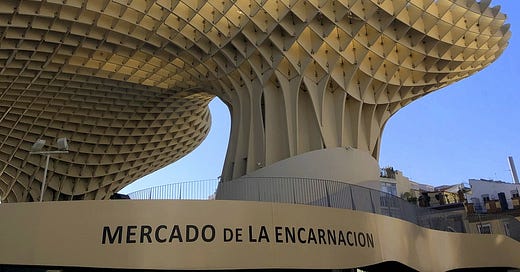



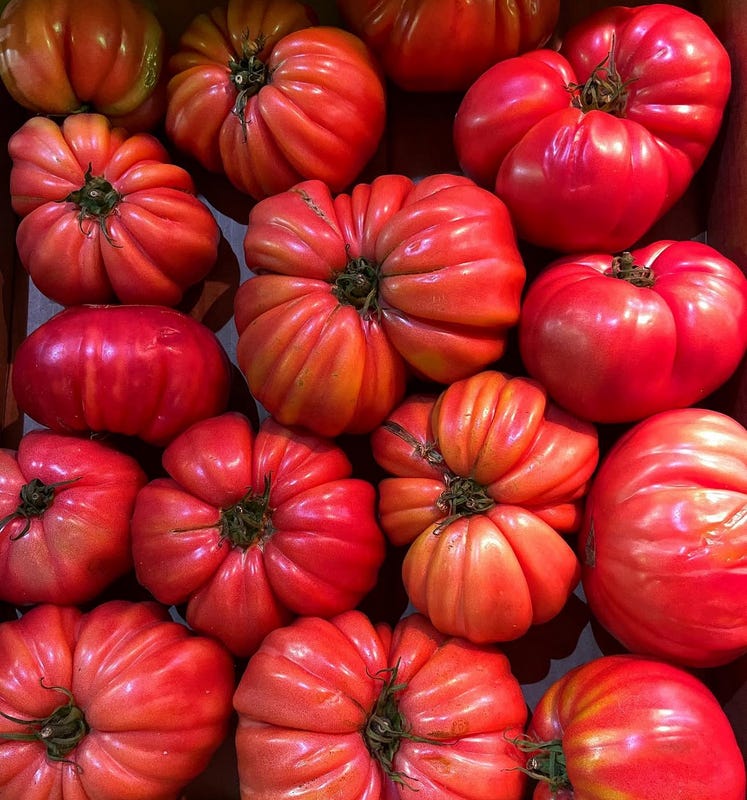
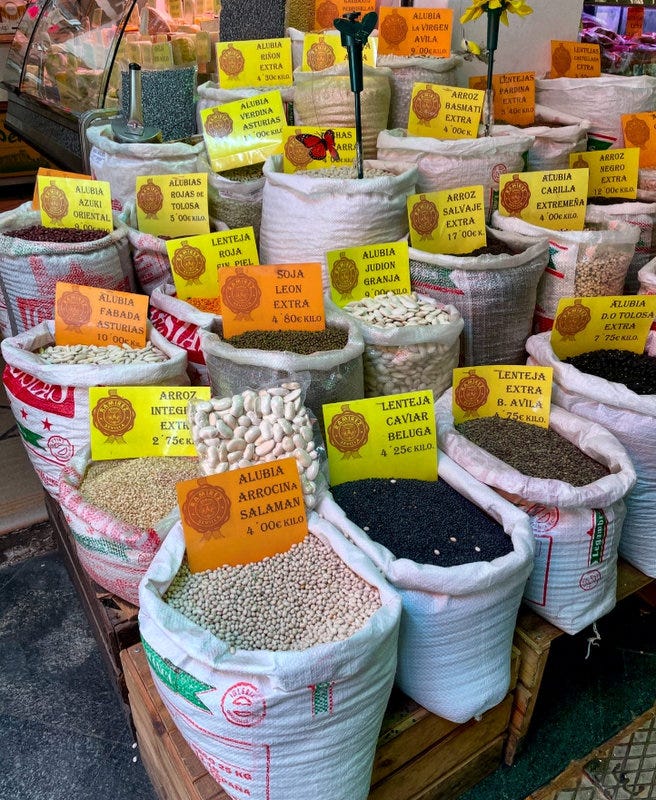
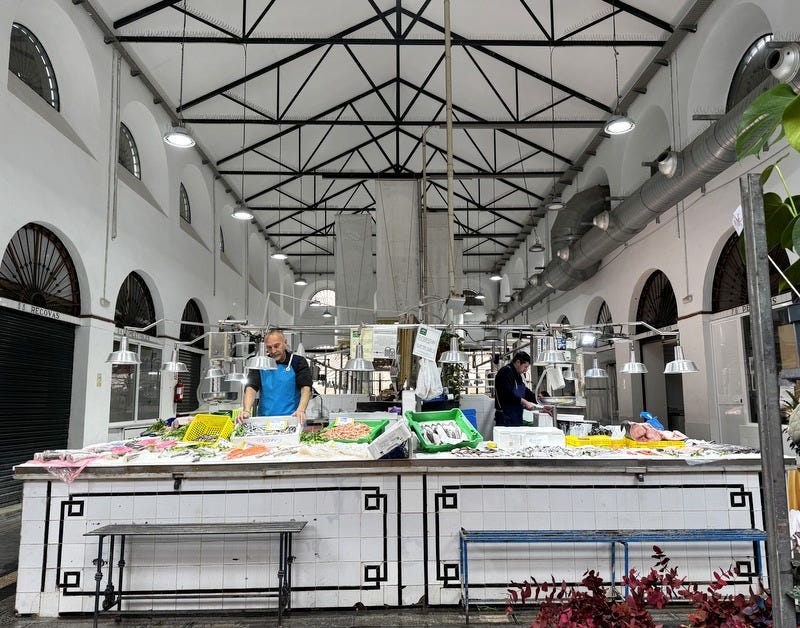
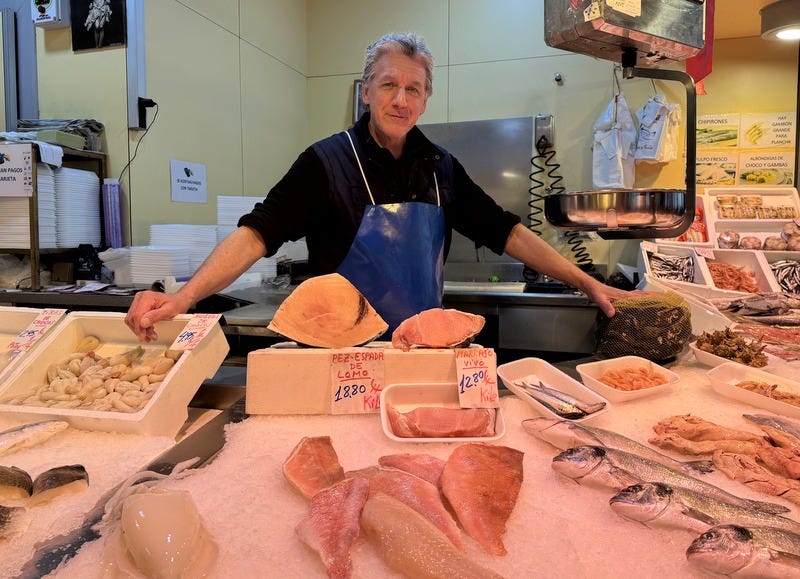

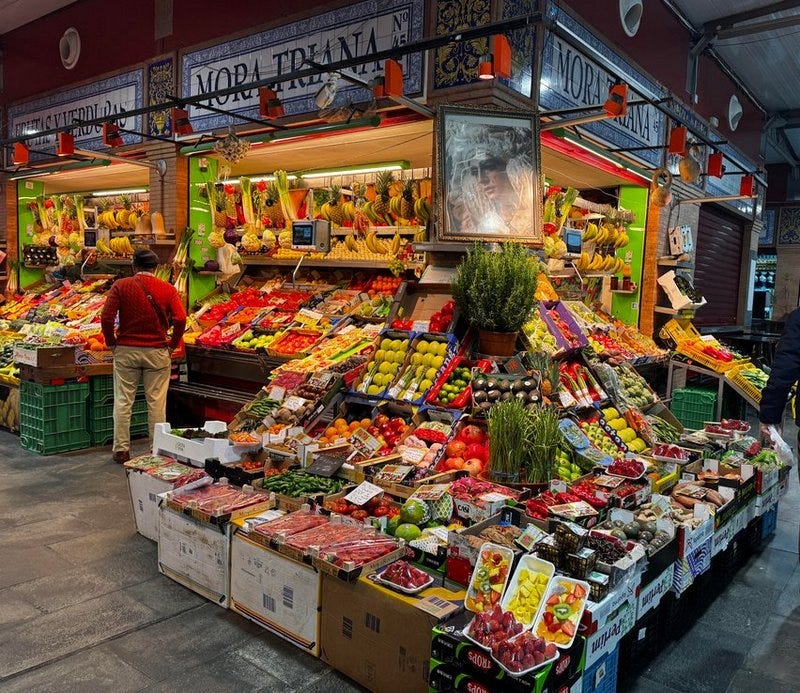
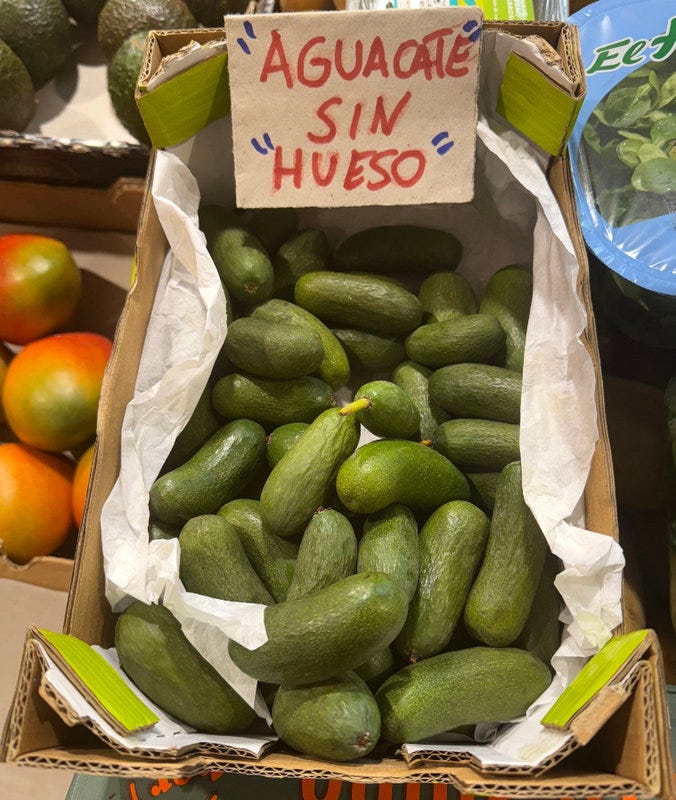
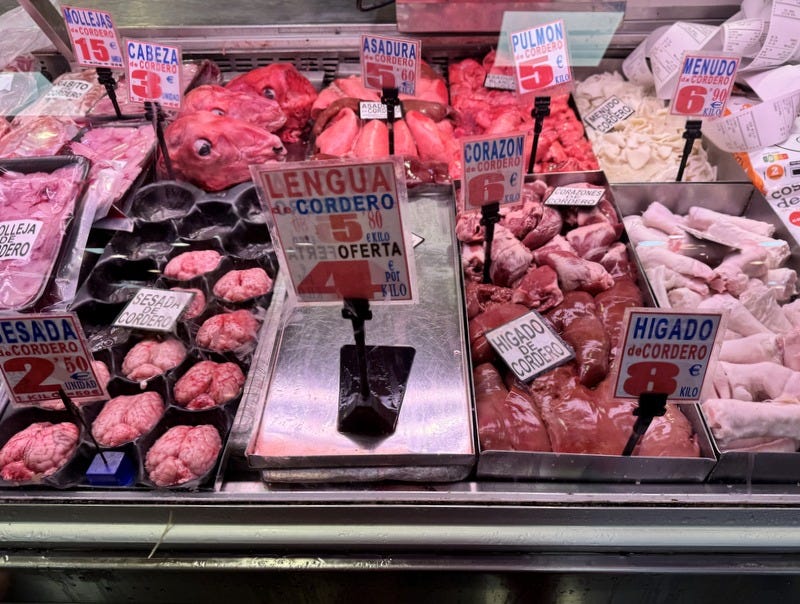
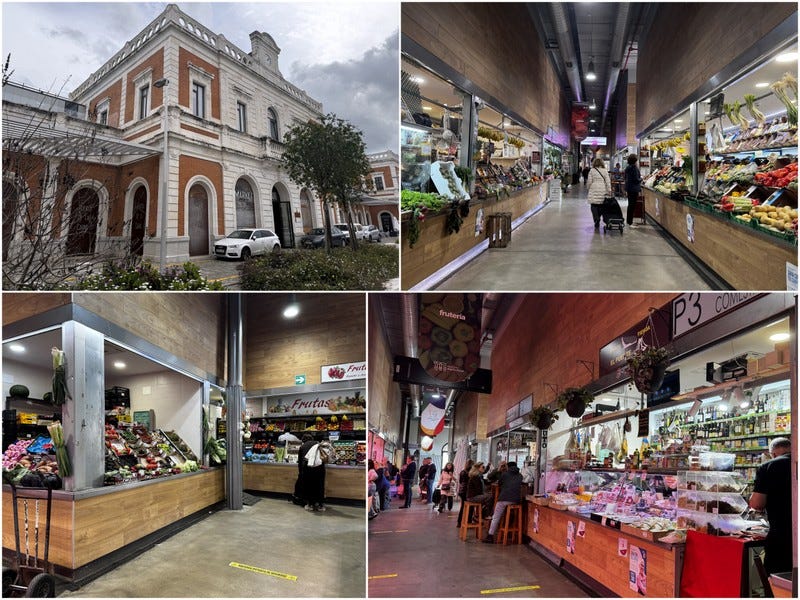
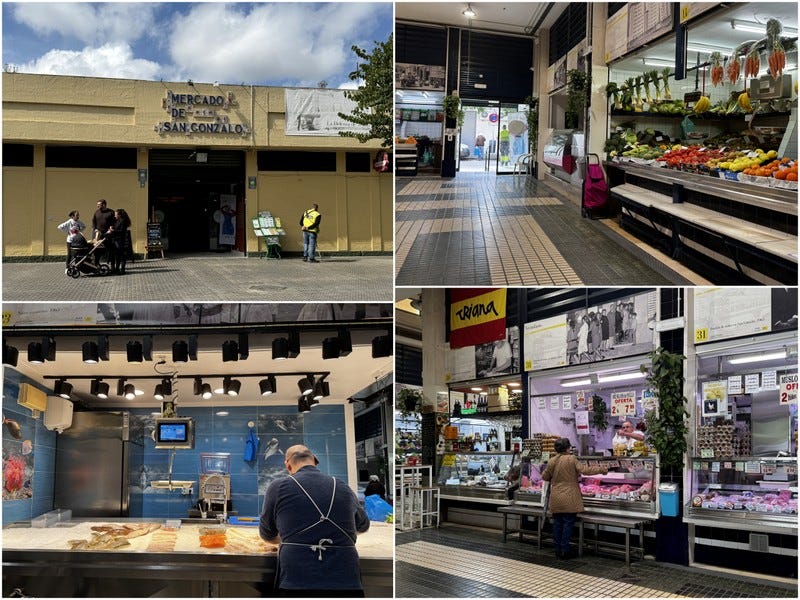
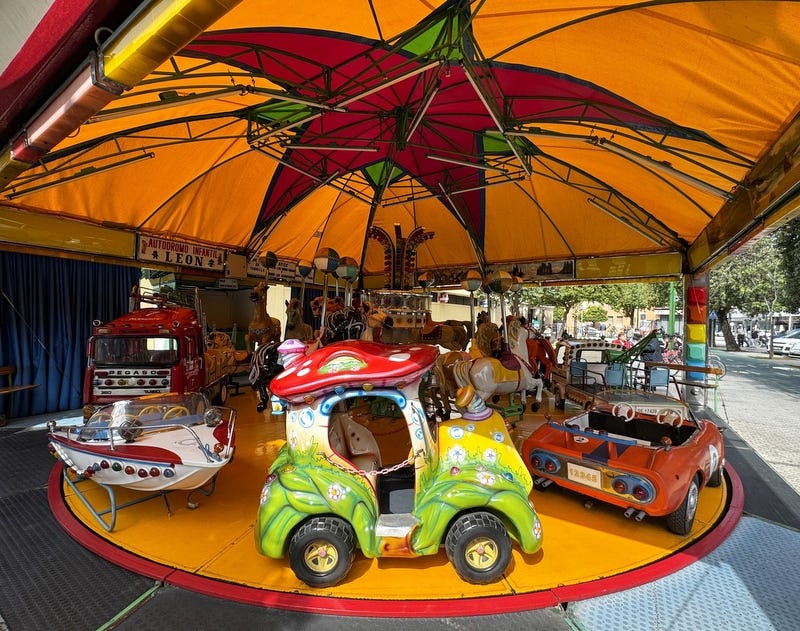

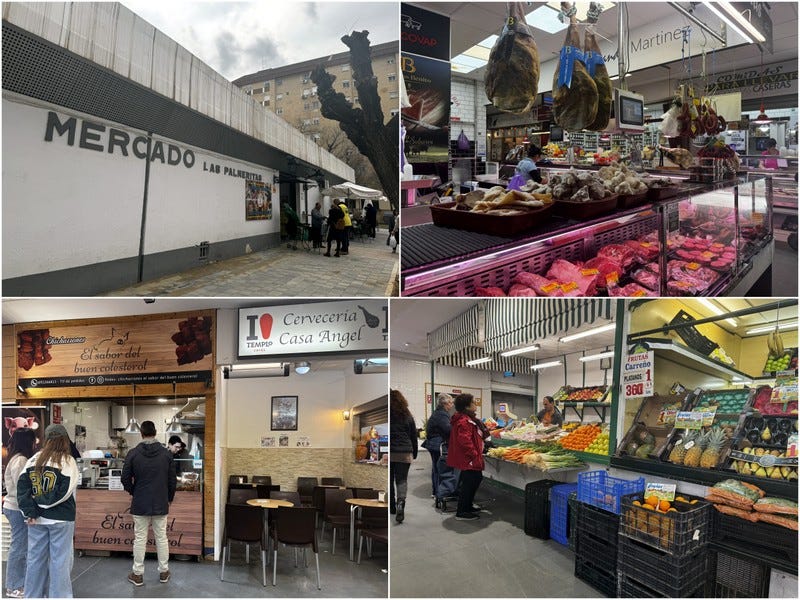
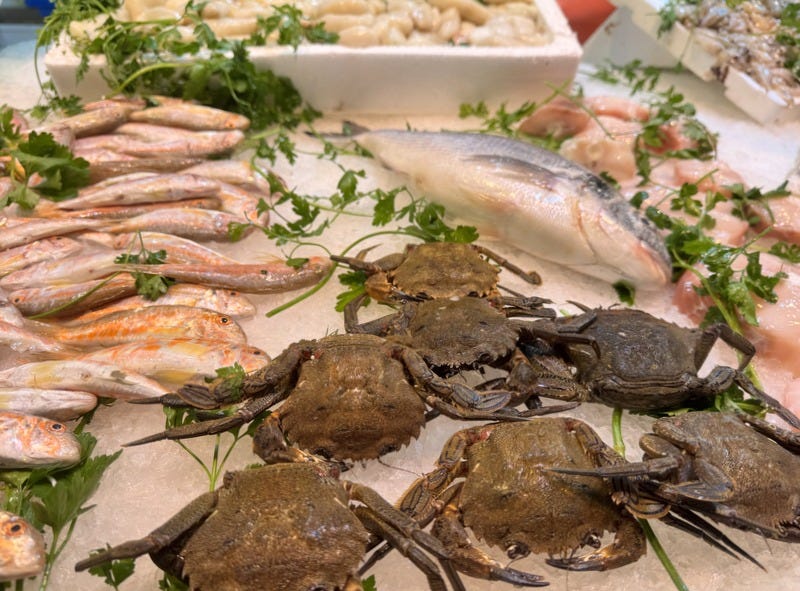
This is a magnificent piece of writing - 11/10 - except for the no fotos suggestion. That is stuck in the past - you can’t complain about declining business AND ban modern FREE advertising at the same time ☮️❤️🍷
I absolutely bloody love markets. Beautiful heartfelt piece Shawn.